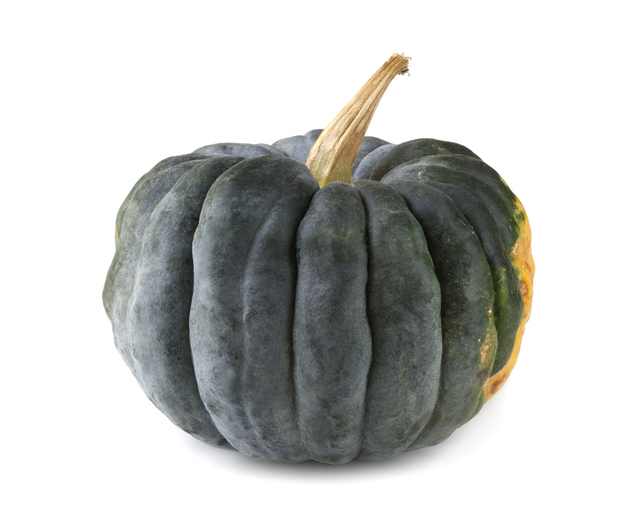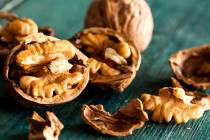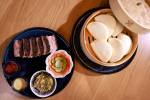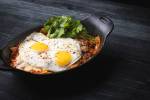Playing with pumpkins a favorite fall pastime for chefs
Quick, “pumpkin.” What comes to mind?
Undoubtedly one of those great big orange things, just perfect for carving or painting or otherwise using to decorate your home for Halloween.
When it comes to cooking or baking with pumpkin, though, the choices are more numerous.
“Pumpkins is no small category,” said Armando Mendez, produce coordinator for Whole Foods Market’s Southern Pacific Region. “Actually, it’s pretty large.”
Anything that’s labeled “pie pumpkin,” Mendez said, is going to be the best choice for pumpkin to be consumed.
Some local chefs were a little more specific about their pumpkin choices.
“I like kabocha, just because the color is very vibrant,” said Brigette Contreras, executive pastry chef at STK at The Cosmopolitan of Las Vegas.
Michael Putnam, executive chef of the Bacchanal Buffet at Caesars Palace, has a whole list of favorites:
Tiger Paw: “It’s green and orange, a little striped. That’s a little harder. We use those for bases of soups, because they tend to be a lot starchier.”
Black futsu: “A little bit darker, like a buckskin color. We’ll do different types of pickled pumpkin … like pickled asparagus or pickled watermelon rind.” They’re not available just in the fall, which means, “you can kind of surprise people with a later summer or early winter type thing.”
Sugar pie: “They have a good sugariness, flavor and not too much water. Most of the time, the canned pumpkin you get in the grocery store, it’s typically a Sugar pie pumpkin.”
Red curry: “Like a teardrop, kind of reddish. Also very sweet, very good to bake with.”
Jack Be Littles: “They’re the really small ones. They’re edible, and have a very strong flavor. Very starchy.”
“There’s so many varieties,” Putnam said. “A lot of them are like heirloom corn, where you don’t eat them; they’re more for display.”
And those are the only pumpkins Rebecca Bills avoids.
“Generally, I would choose smaller ones, because they’re going to be less fibrous and they have less water and are a little sweeter,” said Bills, executive pastry chef for Block 16 Hospitality. “Also look for less-shiny ones, because the shiny ones aren’t quite ripe yet.”
They favor different methods of preparing pumpkin. Mendez cuts it in half, scoops out the seeds to prepare separately and puts the pumpkin halves face down in a sheet pan with about ¼ inch water. He bakes it in a 350-degree oven for 40 to 45 minutes, until it’s fork-tender.
“At that point, turn it over, put it on broil and get some caramelization,” he said.
Contreras likes to cut it in pieces, put it in a pan with a little water, cover with foil and bake it at 350 degrees for about an hour. Then scoop it out, put it in a blender or food processor and puree.
Bills doesn’t like fighting to cut up the hard pumpkin, so she puts the whole thing in the oven and roasts it for 30 to 40 minutes, until it softens a bit. Then she cuts it up, cleans it out, removes the stem and finishes roasting.
“Whatever way, you arrive at the same result, where you have the nice tender flesh of the pumpkin,” said Bills, adding that if the puree seems a little watery, she’ll reduce it in a pan on the stove.
They all said fresh pumpkin is clearly superior to canned.
“It’s more flavorful that way,” Contreras said. “And then you can spice it up with cinnamon and nutmeg, which makes it nice and warm and fall.”
Bills said if you’re following a recipe, assume the writer is thinking of canned pumpkin, which won’t have as much moisture as fresh, and make adjustments if needed.
As for ways to use it, there are many more than those Putnam listed.
“You can broil it, steam it, bake it, soups, pumpkin curries,” Mendez said.
Contreras is serving a pumpkin cheesecake bar with caramel sauce, spiced whipped cream and vanilla ice cream. And pumpkin doughnuts with vanilla ice cream, maple glaze and candied pumpkin seeds.
Putnam said he likes it for savory uses, such as miso-glazed salmon with ginger-spiced pumpkin puree.
“Over the years, we’ve used it so many different ways,” Bills said. “Classics like cheesecake, bread pudding and tarts make it on to the menu once a year.
“To be totally honest, I don’t like to get too adventurous with pumpkin, because that’s something associated with home and family and family recipes, and it’s a really familiar, nostalgic flavor.”
And remember that like in other areas of cooking, there are few rules. Asked what kind of pumpkin he prepares for cooking and baking, Mendez seemed a little sheepish.
“The luminaria, the white pumpkin, bright orange on the inside,” he said. “It isn’t in the pie-pumpkin classification, but they eat fantastic.”
PUMPKIN SOUP WITH BLUE CHEESE TOASTS
¼ cup butter
1/3 cup finely chopped onion
½ cup finely chopped celery
¼ cup finely chopped carrots
1 tablespoon minced shallot
28 ounces (about 3½ cups) canned pumpkin, (not pie mix) or fresh pumpkin puree
2 cups chicken or vegetable broth
1½ cups water
4 sprigs fresh thyme, leaves removed and chopped
½ cup heavy cream
Sea salt and ground black pepper
1 small baguette, sliced into ¼-inch-thick rounds
5 tablespoons blue cheese crumbles
In a large saucepan, melt butter. Add onions, celery, carrots and shallot. Saute over moderate heat until onions become transparent. Add pumpkin, broth and water. Cook until vegetables are tender. Remove from heat and puree the mixture in a blender or processor. Return mixture to saucepan and add chopped thyme and cream.
Reheat over low heat just until hot but do not let boil. Taste and adjust seasoning.
Place baguette slices on a baking sheet and broil until golden brown and crisp. Remove from oven and sprinkle the toasts generously with blue cheese crumbles. Serve soup with toasts floating on top.
Serves 5 to 6.
— Whole Foods Market
WILD RICE STUFFED MINI PUMPKINS
½ cup uncooked wild rice
3 cups water
4 mini pumpkins
1 orange
2 teaspoons honey
Salt and pepper, to taste
¼ cup dried cranberries
2 tablespoons chopped pecans
1 teaspoon orange zest
1 teaspoon chopped mint
Preheat oven to 375 degrees.
In a small saucepan, add wild rice and fill with enough water to cover and allow room to boil like cooking pasta. Bring to a boil and then simmer for approximately 30 to 40 minutes. Rice is done when it starts to “pop” the grain.
While rice cooks, cut tops off pumpkins. Using a large spoon, scoop out seeds and strings. Place pumpkins upside down in a pan with 1/3 inch of water. Bake for 15 minutes. Carefully turn pumpkins upright and return to oven until flesh is tender when pierced with a fork, about 5 to 10 more minutes.
When rice is cooked, pour into a colander and rinse with cold water. Place the rice in a medium-sized bowl.
Zest orange; reserve. Juice it and add honey, mixing together. Pour over rice. Add salt and pepper and stir well. Stir in cranberries, pecans, orange zest and mint. Adjust seasonings if needed. Stuff rice into pumpkins and serve.
Serves 4.
— Whole Foods Market
PUMPKIN HUMMUS
One 15.5-ounce can garbanzo beans (also called chickpeas), drained and rinsed
One 15-ounce can pumpkin puree, or equivalent fresh puree
3 tablespoons tahini
1 tablespoon lemon juice
¾ teaspoon ground cumin
¾ teaspoon fine sea salt
¼ cup pumpkin seeds
Combine garbanzos, pumpkin puree, tahini, lemon juice, cumin and salt in a food processor and process until creamy and smooth. Transfer to a bowl, cover and refrigerate for at least 1 hour and for as long as 5 days. Garnish with pumpkin seeds.
Makes about 3 cups.
— Whole Foods Market
Contact Heidi Knapp Rinella at Hrinella@reviewjournal.com. Find more of her stories at www.reviewjournal.com, and follow @HKRinella on Twitter.
Don't forget the pumpkin seeds
Armando Mendez, produce coordinator for Whole Foods Market's Southern Pacific Region, scoops out the seeds and doesn't wash them, preferring to let the pulp caramelize on the seeds.
He adds salt, spices such as cumin, cayenne and/or curry powder and bakes them at 300 degrees for about 45 minutes, stirring every 15 minutes.
For candied pumpkin seeds, Brigette Contreras, executive pastry chef of STK at The Cosmopolitan of Las Vegas, mixes some brown butter, sugar, a little maple syrup and a little bit of sea salt to form a paste. Then she tosses the pumpkin seeds in the mixture, then bakes and cools them.
"It kind of comes out like a brittle, and then you just break it up," she said.
"Or we dry them at a low temperature and then I do a spice mix with salt and a little paprika, and we just snack on those," she said.
— Heidi Knapp Rinella






































